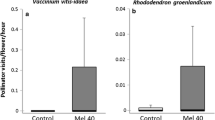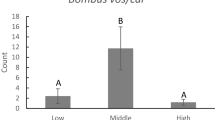Abstract
When exotic plant species share pollinators with native species, competition for pollination may lower the reproductive success of natives by reducing the frequency and/or quality of visits they receive. Exotic species often become numerically dominant in plant communities, and the relative abundance of these potential competitors for pollination may be an important determinant of their effects on the pollination and reproductive success of co-occurring native species. Our study experimentally tests whether the presence and abundance of an invasive exotic, Lythrum salicaria L. (Lythraceae), influences reproductive success of a co-flowering native species, Mimulus ringens L. (Phrymaceae). We also examine the mechanisms of competition for pollination and how they may be altered by changes in competitor abundance. We found that the presence of Lythrum salicaria lowered mean seed number in Mimulus ringens fruits. This effect was most pronounced when the invasive competitor was highly abundant, decreasing the number of seeds per fruit by 40% in 2006 and 33% in 2007. Reductions in the number of seeds per fruit were likely due to reduced visit quality resulting from Mimulus pollen loss when bees foraged on neighboring Lythrum plants. This study suggests that visit quality to natives may be influenced by the presence and abundance of invasive flowering plants.




Similar content being viewed by others
References
Agren J (1996) Population size, pollinator limitation, and seed set in the self-incompatible herb Lythrum salicaria. Ecology 77:1779–1790
Bell JM, Karron JD, Mitchell RJ (2005) Interspecific competition for pollination lowers seed production and outcrossing rate in Mimulus ringens. Ecology 86:762–771
Bjerknes AL, Totland O, Hegland SJ, Neilsen A (2007) Do alien plant invasions really affect pollination success in native plant species? Biol Conserv 138:1–12
Blossey BL, Skinner O, Taylor J (2001) Impact and management of purple loosestrife (Lythrum salicaria) in North America. Biodivers Conserv 10:1787–1807
Brown BJ, Mitchell RJ (2001) Competition for pollination: effects of pollen of an invasive plant on seed set of a native congener. Oecologia 129:43–49
Brown BJ, Mitchell RJ, Graham SA (2002) Competition for pollination between an invasive species (purple loosestrife) and a native congener. Ecology 83:2328–2336
Campbell DR (1985) Pollinator sharing and seed set of Stellaria pubera: competition for pollination. Ecology 66:544–563
Campbell DR, Motten AF (1985) The mechanism of competition for pollination between two forest herbs. Ecology 66:554–563
Caruso CM (2002) Influence of plant abundance on pollination and selection on floral traits of Ipomopsis aggregata. Ecology 83:241–254
Caruso CM, Alfaro M (2000) Interspecific pollen transfer as a mechanism of competition: effect of Castilleja linariaefolia pollen on seed set of Ipomopsis aggregata. Can J Bot 78:600–606
Chittka L, Schurkens S (2001) Successful invasion of a floral market. Nature 411:653
Dafni A, Kevan PG, Husband BC (eds) (2005) Practical pollination biology. Enviroquest, Cambridge
Darwin C (1877) The different forms of flowers on plants of the same species. Appleton, New York
DiFazio SP, Wilson MV, Vance NC (1998) Factors limiting seed production of Taxus brevifolia (Taxaceae) in western Oregon. Am J Bot 85:910–918
Farnsworth EJ, Ellis DR (2001) Is purple loosestrife (Lythrum salicaria) an invasive threat to freshwater wetlands? Conflicting evidence. Wetlands 21:199–209
Feinsinger P, Tiebout HM III (1991) Competition among plants sharing hummingbird pollinators: laboratory experiments on a mechanism. Ecology 72:1946–1952
Feinsinger P, Busby WH, Tiebout HM III (1988) Effects of indiscriminate foraging by tropical hummingbirds on pollination and plant reproductive success: experiments with two tropical treelets (Rubiaceae). Oecologia 76:471–474
Feldman TS, Morris WF, Wilson WG (2004) When can two plants facilitate each other’s pollination? Oikos 105:197–207
Flanagan RJ, Mitchell RJ, Knutowski D, Karron JD (2009) Interspecific pollinator movements reduce pollen deposition and seed production in Mimulus ringens (Phrymaceae). Am J Bot 96:809–815
Galen C, Gregory T (1989) Interspecific pollen transfer as a mechanism of competition: consequences of foreign pollen contamination for seed set in the alpine wildflower, Polemonium viscosum. Oecologia 81:120–123
Ghazoul J (2004) Alien abduction: disruption of native plant-pollinator interactions by invasive species. Biotropica 36:156–164
Ghazoul J (2006) Floral diversity and the facilitation of pollination. J Ecol 94:295–304
Grant AL (1924) A monograph of the genus M. ringens. Ann M Bot Gard 11:99–389
Griffin SR, Barrett SCH (2002) Factors affecting low seed-ovule ratios in a spring woodland herb, Trillium grandiflorum (Melanthiaceae). Int J Plant Sci 163:581–590
Hager H, McCoy KD (1998) The implications of accepting untested hypotheses: a review of the effects of purple loosestrife (Lythrum salicaria) in North America. Biodivers Conserv 7:1069–1079
Harder LD, Wilson WG (1998) Theoretical consequences of heterogeneous transport conditions for pollen dispersal by animals. Ecology 79:2789–2807
Husband BC, Barrett SCH (1992) Pollinator visitation in populations of tristylous Eichhornia paniculata in northeastern Brazil. Oecologia 89:365–371
Inouye DW, Gill DE, Dudash MR, Fenster CB (1994) A model and lexicon for pollen fate. Am J Bot 81:1517–1530
Ippolito A, Fernandes GW, Holtsford TP (2004) Pollinator preferences for Nicotiana alata, N. forgetiana, and their F1 Hybrids. Evolution 58:2634–2644
Jakobsson A, Padron B, Traveset A (2008) Pollen transfer from invasive Carpobrotus spp. to natives—a study of pollinator behaviour and reproduction success. Biol Conserv 141:136–145
Johnson SD, Peter CI, Nilsson LA, Agren J (2003) Pollination success in a deceptive orchid is enhanced by co-occurring rewarding magnet plants. Ecology 84:2919–2927
Kandori I, Hirao T, Matsunaga S, Kurosaki T (2009) An invasive dandelion unilaterally reduces the reproduction of a native congener through competition for pollination. Oecologia 159:559–569
Karron JD, Thumser NN, Tucker R, Hessenauer AJ (1995a) The influence of population density on outcrossing rates in Mimulus ringens. Heredity 75:175–180
Karron JD, Tucker R, Thumser NN, Reinartz JA (1995b) Comparison of pollinator flight movements and gene dispersal patterns in Mimulus ringens. Heredity 75:612–617
Karron JD, Jackson RT, Thumser NN, Schlicht SL (1997) Outcrossing rates of individual Mimulus ringens genets are correlated with anther–stigma separation. Heredity 79:365–370
Karron JD, Mitchell RJ, Holmquist KG, Bell JM, Funk B (2004) The influence of floral display size on selfing rates in Mimulus ringens. Heredity 92:242–248
Karron JD, Mitchell RJ, Bell JM (2006) Multiple pollinator visits to Mimulus ringens (Phrymaceae) flowers increase mate number and seed set within fruits. Am J Bot 93:1306–1312
Karron JD, Holmquist K, Flanagan RJ, Mitchell RJ (2009) Pollinator visitation patterns strongly influence among-flower variation in selfing rate. Ann Bot 103:1379–1383
Klinkhamer PGL, DeJong TJ (1987) Plant size and seed production in the monocarpic perennial Cynoglossum officinale L. New Phytol 106:773–783
Larson DL, Royer RA, Royer MR (2006) Insect visitation and pollen deposition in an invaded prairie plant community. Biol Conserv 130:148–159
Lopezaraiza-Mikel ME, Hayes RB, Whalley R, Memmott J (2007) The impact of an alien plant on a native plant-pollinator network: an experimental approach. Ecol Lett 10:539–550
Mal TK, Lovett-Doust J, Lovett-Doust L, Mulligan GA (1992) The biology of Canadian weeds. 100. Lythrum salicaria. Can J Plant Sci 72:1305–1330
Mitchell RJ, Karron JD, Holmquist KG, Bell JM (2004) The influence of Mimulus ringens floral display size on pollinator visitation patterns. Funct Ecol 18:116–124
Mitchell RJ, Karron JD, Holmquist KG, Bell JM (2005) Patterns of multiple paternity in fruits of Mimulus ringens (Phrymaceae). Am J Bot 92:885–890
Mitchell RJ, Flanagan RJ, Brown BJ, Waser NM, Karron JD (2009a) New frontiers in competition for pollination. Ann Bot 103:1403–1413
Mitchell RJ, Irwin RE, Flanagan RJ, Karron JD (2009b) Ecology and evolution of plant-pollinator interactions. Ann Bot 103:1355–1363
Moeller DA (2004) Facilitative interactions among plants via shared pollinators. Ecology 85:3289–3301
Molina-Montenegro MA, Badano EI, Cavieres LA (2008) Positive interactions among plant species for pollinator service: assessing the ‘magnet species’ concept with invasive species. Oikos 117:1833–1839
Morales CL, Aizen MA (2006) Invasive mutualisms and the structure of plant-pollinator interactions in the temperate forests of north-west Patagonia, Argentina. J Ecol 94:171–180
Morales CL, Traveset A (2008) Interspecific pollen transfer: magnitude, prevalence, and consequences for plant fitness. Crit Rev Plant Sci 27:221–238
Morales CL, Traveset A (2009) A meta-analysis of impacts of alien vs. native plants on pollinator visitation and reproductive success of co-flowering native plants. Ecol Lett 12:716–728
Munoz AA, Cavieres LA (2008) The presence of a showy invasive plant disrupts pollinator service and reproductive output in native alpine species only at high densities. J Ecol 96:459–467
Murcia C, Feinsinger P (1996) Interspecific pollen loss by hummingbirds visiting flower mixtures: effects of floral architecture. Ecology 77:550–560
Newman JA, Bergelson J J, Grafen A (1997) Blocking factors and hypothesis tests in ecology: is your statistics text wrong? Ecology 78:1312–1320
Rathcke B (1983) Competition and facilitation among plants for pollination. In: Real L (ed) Pollination biology. Academic, Orlando, pp 305–309
SAS Institute (2004) JMP version 5.1.2 statistical software. SAS Institute, Cary
Shimono A, Washitani I (2007) Factors affecting variation in seed production in the heterostylous herb Primula modesta. Plant Species Biol 22:65–76
Sokal RR, Rohlf FJ (1995) Biometry: the principles and practice of statistics in biological research, 3rd edn. Freeman, New York
Takakura K, Nishida T, Matsumoto T, Nishida S (2009) Alien dandelion reduces the seed-set of a native congener through frequency-dependent and one-sided effects. Biol Invasions 11:973–981
Thompson DQ, Stuckey RL, Thompson EB (1987) Spread, impact and control of purple loosestrife in North American wetlands. US Fish and Wildlife Research, Washington DC
Thomson JD (1978) Effect of stand composition on insect visitation in two-species mixtures of Hieracium. Am Midl Nat 100:431–440
Thomson JD (1986) Pollen transport and deposition by bumble bees in Erythronium: influences of floral nectar and bee grooming. J Ecol 74:329–341
Totland O, Nielsen A, Bjerknes AJ, Ohlson M (2006) Effects of an exotic plant and habitat disturbance on pollinator visitation and reproduction in a boreal forest herb. Am J Bot 93:868–873
Waser NM (1978) Competition for pollination and sequential flowering in two Colorado wildflowers. Ecology 59:934–944
Waser NM (1983) Competition for pollination and floral character differences among sympatric plant species: a review of evidence. In: Jones CE, Little RJ (eds) Handbook of experimental pollination biology. Van Nostrand Reinhold, New York, pp 277–293
Waser NM, Fugate ML (1986) Pollen precedence and stigma closure: a mechanism of competition for pollination between Delphinium nelsonii and Ipomopsis aggregata. Oecologia 70:573–577
Acknowledgments
The authors thank T. Schuck for assistance propagating Mimulus ringens and J. Reinartz, G. Meyer, and L. Nelson for help with field work. We thank S. Johnson, O. Totland, and an anonymous reviewer for helpful comments on an earlier draft of this manuscript. This research was supported by a grant from Applied Ecological Services to R. J. F. and grants from the National Science Foundation to J. D. K. (DEB 9816712) and R. J. M. (DEB 9903308). This experiment complies with the current laws of the United States of America.
Author information
Authors and Affiliations
Corresponding author
Additional information
Communicated by Steven Johnson.
Rights and permissions
About this article
Cite this article
Flanagan, R.J., Mitchell, R.J. & Karron, J.D. Increased relative abundance of an invasive competitor for pollination, Lythrum salicaria, reduces seed number in Mimulus ringens . Oecologia 164, 445–454 (2010). https://doi.org/10.1007/s00442-010-1693-2
Received:
Accepted:
Published:
Issue Date:
DOI: https://doi.org/10.1007/s00442-010-1693-2




